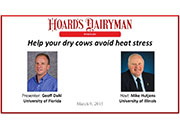 The signs of heat stress in dry cows are less obvious when there is no production to monitor. In the March Hoard's Dairyman webinar, Geoff Dahl, University of Florida, presented, "Help your dry cows avoid heat stress." Dahl has conducted numerous studies in the southeast heat and looks specifically at the dry period.
The signs of heat stress in dry cows are less obvious when there is no production to monitor. In the March Hoard's Dairyman webinar, Geoff Dahl, University of Florida, presented, "Help your dry cows avoid heat stress." Dahl has conducted numerous studies in the southeast heat and looks specifically at the dry period. His research studied two different groups – those that were cooled during the dry period and those that were not. The only variable in his research was the dry period, as cows were managed under the exact same circumstances for their entire lives.
The heat-stressed dry cow can be seen with an elevated respiration rate, depressed feed intake and a higher rectal temperature. However, negative effects on her body may already be ongoing before someone observes the physical signs.
His studies conducted on contemporaries, showed non heat-stressed cows when challenged with strep uberis at five days into lactation responded better to treatment. The cooler dry period improved their immune response.
When observing seasonality, cows with a dry period in the cooler months of December, January and February, produced 1200 to 1300 more pounds of milk than cows that were dry in the warmer month of June, July and August. Cooled cows also experienced less mastitis, as well as fewer digestive issues, retained placentas and respiratory challenges.
A surprising finding is that breeding efficiency didn't decrease for cows bred in hot months, but it did decline for cows that were dry in hot months.
Cooling cows increased milk production due to healthy mammary cell growth during the dry period. There was also increased dry matter intake, body condition score and body weight during the transition period – all positive contributors to milk production. Overall immunity was also heightened.
The heat also impacts the developing fetus. When comparing cows only cooled during the dry period to cows not cooled in the dry period, the resulting calf was shorter (in stature) and weighed 5 pounds less. Those heat-stressed cows' offspring did not catch up to their cooled herdmates' weaning weights or size, and were still not equal, even at the yearling stage.
Heat-stressed cows didn't have colostrum quality issues. However, the calf's ability to utilize those antibodies was sacrificed. The IgG absorption efficiency was lower for calves born to heat-stressed dams. Keep in mind that the dams were under identical management for their entire lifetimes, except for the dry period when half were cooled.
Even beyond the initial cow benefits, animals born to cooled cows were culled less frequently, had less illness, more of them completed their first lactation and produced more milk. His research confirms cooled days in the dry period impact the cow and the newborn calf far beyond calving.
Learn more about dairy efficiencies, watch the March webinar. It's archived and available for viewing. Past webinars can be found at www.hoards.com/webinars.
Webinars, Animal Care or Dairy Management follow these links.

The author is the online media manager and is responsible for the website, webinars and social media. A graduate of Modesto Junior College and Fresno State, she was raised on a California dairy and frequently blogs on youth programs and consumer issues.








